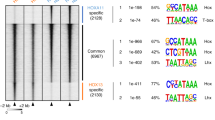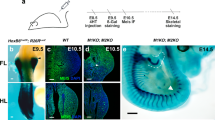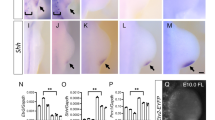Abstract
The homoeobox-containing genes of the Hox-5 complex are expressed in different but overlapping domains in limbs during murine development. The more 5′ the position of these genes in the complex, the later and more distal is their expression. Antero-posterior differences are also observed. A model is proposed that accounts for the establishment of these expression domains in relation to the existence of a morphogen released by the zone of polarizing activity. Comparison of these observations with the expression patterns of the genes of Hox complexes in the early embryo suggests that similar molecular mechanisms are involved in the positional signalling along the axes of both the embryonic trunk and the fetal limbs.
This is a preview of subscription content, access via your institution
Access options
Subscribe to this journal
Receive 51 print issues and online access
$199.00 per year
only $3.90 per issue
Buy this article
- Purchase on Springer Link
- Instant access to full article PDF
Prices may be subject to local taxes which are calculated during checkout
Similar content being viewed by others
References
Saunders, J. W. & Gasseling, M. T. in Epithelial-Mesenchymal Interactions 78–79 (Williams & Wilins, Baltimore, 1968).
Tickle, C., Summerbell, D. & Wolpert, L. Nature 254, 199–202 (1975).
Tickle, C., Shilswell, G., Crawley, A. & Wolpert, L. Nature, 259, 396–397 (1976).
Summerbell, D., Lewis, J. H. & Wolpert, L. Nature 244, 492–496 (1973).
Tickle, C., Lee, J. & Eichele, G. Dev Biol. 109, 82–95 (1985).
Thaller, C. & Eichele, G. Nature 397, 553–554 (1987).
Zwilling, E. Adv. Morph. 1. 301–330 (1981).
Saunders, I. W. in Limb Development and Deformity (ed. C. A. Swinyard) 84–100 (Thomas, Illinois,1969).
Savard, P., Gates, P. D. & Brockes, J. P. EMBO J. 7, 4275–4282 (1988).
Dollé, P. & Duboule, D. EMBO J. 8, 1507–1515 (1989).
Oliver, G. et al. Genes Dev. 3, 641–650 (1989).
Brockes, J. Neuron 2, 1285–1294 (1989).
Duboule, D. & Dollé, P. EMBO J. 8, 1497–1505 (1989).
Featherstone, M. S. et al. Proc. natn Acad. Sci. U.S.A. 85, 4760–4764 (1988).
Hinchcliffe, J. R. & Johnson, D. R. The Development of the Vertebrate Limb (Clavendon, Oxford 1980).
Rugh, R. The Mouse, its Reproduction and Development (Burgess, Minneapolis, 1968)
Lewis, E. B., Nature 276, 565–570 (1978).
Peifer, M., Karch, F. & Bender, W. Genes Dev. 1, 891–898 (1987)
Akam, M., Dawson, I. & Tear, G. Development (suppl.) 104, 123–133 (1988).
Newman, S. A. & Frisch, H. L. Science 205, 662–668 (1979).
Wolpert, L. J. theor. Biol. 25, 1–47 (1969).
Wilby, O. K. & Ede, D. A. J. theor. Biol. Vol 52, 199–217 (1975).
Hoey, T. & Levine, M. Nature 332, 858–861 (1988).
Otting, G. et al EMBO J. 7, 4305–4309 (1988).
Satre, N. A. & Kochhar, D. N. Dev Biol. 133, 529–536 (1989).
Zelent, A. et al. Nature 339, 714–717 (1989).
Dolle, P., Ruberte, E., Kastner, P., Petkovich, M., Stoner, C. M., Gudas, L. J. & Chambon, P. Nature 342, 702–705 (1989).
Gaunt, S. J., Sharpe, P. T. & Duboule, D. Development (suppl.) 104, 169–179 (1988)
Gaunt, S. J. Development 103, 135–144 (1988).
Holland, P. W. H. & Hogan, B. L. M. Genes Dev. 2, 773–782 (1988).
Graham, A. Papalopulu, N. & Krumlauf, R. Cell 57, 367–378 (1989).
Hornbruch, A. & Wolpert, L. J. Embryol. exp. Morph. 99, 257–265 (1986).
Hogan, B. et al. Trends Genet. 1, 67–74 (1985).
Gaunt, S. J. Development 101, 51–60 (1987).
Galliot, B. et al. Development 107, 343–359 (1989).
Author information
Authors and Affiliations
Rights and permissions
About this article
Cite this article
Dollé, P., Izpisúa-Belmonte, JC., Falkenstein, H. et al. Coordinate expression of the murine Hox-5 complex homoeobox-containing genes during limb pattern formation. Nature 342, 767–772 (1989). https://doi.org/10.1038/342767a0
Received:
Accepted:
Issue Date:
DOI: https://doi.org/10.1038/342767a0
This article is cited by
-
Sequential and directional insulation by conserved CTCF sites underlies the Hox timer in stembryos
Nature Genetics (2023)
-
Non-collinear Hox gene expression in bivalves and the evolution of morphological novelties in mollusks
Scientific Reports (2021)
-
Differential gene methylation and expression of HOX transcription factor family in orbitofacial neurofibroma
Acta Neuropathologica Communications (2020)
-
Fryns type mesomelic dysplasia of the upper limbs caused by inverted duplications of the HOXD gene cluster
European Journal of Human Genetics (2020)
-
Reduced H3K27me3 leads to abnormal Hox gene expression in neural tube defects
Epigenetics & Chromatin (2019)
Comments
By submitting a comment you agree to abide by our Terms and Community Guidelines. If you find something abusive or that does not comply with our terms or guidelines please flag it as inappropriate.



